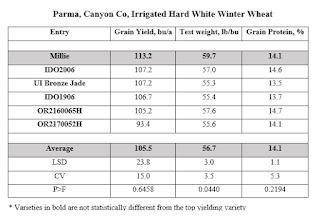Pages
- HOME
- ABOUT
- SCHOLARLY PUBLICATIONS
- RESEARCH
- TEACHING & MENTORING
- EXTENSION & OUTREACH
- SERVICE
- UI Parma Agronomy Program
- Idaho Crops & Soils Newsletter
- Southwest Idaho Cereals Program
- Nutrient 4Rs
- Soil Health
- University of Idaho AgTalk Tuesdays
- Western Ag Variety Explorer - WAVE
- UAV for Fruit Tree Monitoring
- Micronutrients for Wheat
- Precision Irrigation for Hops
- Water and Soil Management for Beans
- Nitrogen and Water Management for Sugar Beets
- Water and Nutrient Footprint of Pulse Crops
- PLSC 500 - Master's Research & Thesis
January 12, 2023
January 10, 2023
Wheat Yield and Protein Estimation with Handheld and Unmanned Aerial Vehicle-Mounted Sensors.
Wheat Yield and Protein Estimation with Handheld and Unmanned Aerial Vehicle-Mounted Sensors
1
Parma R&E Center, University of Idaho, Parma, ID 83660, USA
2
Idaho Falls R&E Center, University of Idaho, Idaho Falls, ID 83402, USA
3
Aberdeen R&E Center, University of Idaho, Aberdeen, ID 83210, USA
4
AG Idaho Consulting LLC, Wilder, ID 83676, USA
*
Author to whom correspondence should be addressed.
Agronomy 2023, 13(1), 207; https://doi.org/10.3390/agronomy13010207 (registering DOI)
Received: 11 November 2022 / Revised: 29 December 2022 / Accepted: 2 January 2023 / Published: 10 January 2023
Abstract
Accurate sensor-based prediction of crop yield and grain quality in-season would enable growers to adjust nitrogen (N) fertilizer management for optimized production. This study assessed the feasibility (and compared the accuracy) of wheat (Triticum aestivum L.) yield, grain N uptake, and protein content prediction with in-season crop spectral reflectance measurements (Normalized Difference Vegetative Index, NDVI) obtained with a handheld GreenSeeker (GS) sensor and an Unmanned Aerial Vehicle (UAV)-mounted sensor. A strong positive correlation was observed between GS NDVI and UAV NDVI at Feekes 5 (R2 = 0.78) and Feekes 10 (R2 = 0.70). At Feekes 5, GS NDVI and UAV NDVI explained 42% and 43% of wheat yield, respectively. The correlation was weaker at Feekes 10 (R2 of 0.34 and 0.25 for GS NDVI and UAV NDVI, respectively). The accuracy of wheat grain N uptake prediction was comparable to that of yield: the R2 values for GS NDVI and UAV NDVI were 0.53 and 0.37 at Feekes 5 and 0.13 and 0.20 at Feekes 10. We found that neither GS NDVI nor UAV NDVI in-season data were useful in prediction of wheat grain protein content. In conclusion, wheat yield and grain N uptake can be estimated at Feekes 5 using either handheld or aerial based NDVI with comparable accuracy.
Keywords:
normalized difference vegetative index; handheld sensor; unmanned aerial vehicle; wheat; grain yield; grain protein; grain N uptakeWe hypothesized that the in-season NDVI from handheld (GS) and aerial (UAV) sensors can be used to accurately estimate wheat yield, grain N uptake, and protein content. Our results have confirmed that wheat yield and grain N uptake can be estimated with GS NDVI and UAV NDVI. We observed a strong linear relationship between GS NDVI and UAV NDVI (0.78), especially at tillering. The GS NDVI and UAV NDVI relationship with wheat yield and N uptake was stronger at tillering compared to flowering. This makes sense because at tillering the plant vigor is high and most of N uptake is channeled towards biomass production. In contrast, at the flowering stage, the N uptake direction is shifted towards grain production. The GS NDVI and UAV NDVI correlation with wheat yield and grain N uptake were comparable. We found that neither GS NDVI nor UAV NDVI in-season data were particularly useful in the prediction of wheat grain protein content.
Author Contributions: Conceptualization, O.S.W. and J.M.M.; Methodology, O.S.W. and J.M.-C.; Investigation, J.M.-C. and C.A.J.; Data curation, O.S.W., E.N., R.L., E.O.A. and F.B.; Writing—original draft, E.N.; Writing—review and editing, O.S.W. and E.N.; Visualization, O.S.W.; Supervision, O.S.W. and J.M.-C.; Project administration, O.S.W. and J.M.M.; Funding acquisition, O.S.W. and J.M.M. All authors have read and agreed to the published version of the manuscript.
Funding: This work was funded in part by the Idaho Wheat Commission and the Idaho wheat producers.
Subscribe to:
Comments (Atom)











